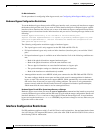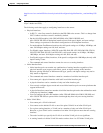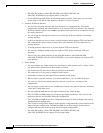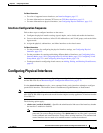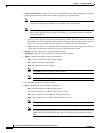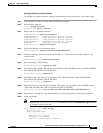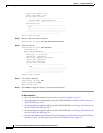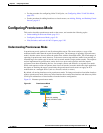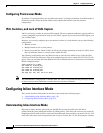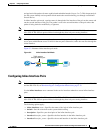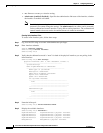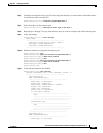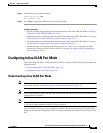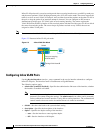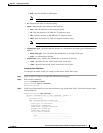
5-20
Cisco Intrusion Prevention System CLI Sensor Configuration Guide for IPS 7.1
OL-19892-01
Chapter 5 Configuring Interfaces
Configuring Inline Interface Mode
Configuring Promiscuous Mode
By default, all sensing interfaces are in promiscuous mode. To change an interface from inline mode to
promiscuous mode, delete the inline interface that contains that interface from the interface
configuration.
IPv6, Switches, and Lack of VACL Capture
VACLs on Catalyst switches do not have IPv6 support. The most common method for copying traffic to
a sensor configured in promiscuous mode is to use VACL capture. If you want to have IPv6 support, you
can use SPAN ports.
However, you can only configure up to two monitor sessions on a switch unless you use the following
configuration:
• Monitor session
• Multiple trunks to one or more sensors
• Restrict per trunk port which VLANs are allowed to perform monitoring of many VLANs to more
than two different sensors or virtual sensors within one IPS
The following configuration uses one SPAN session to send all of the traffic on any of the specified
VLANs to all of the specified ports. Each port configuration only allows a particular VLAN or VLANs
to pass. Thus you can send data from different VLANs to different sensors or virtual sensors all with one
SPAN configuration line:
clear trunk 4/1-4 1-4094
set trunk 4/1 on dot1q 930
set trunk 4/2 on dot1q 932
set trunk 4/3 on dot1q 960
set trunk 4/4 on dot1q 962
set span 930, 932, 960, 962 4/1-4 both
Note The SPAN/Monitor configuration is valuable when you want to assign different IPS policies per VLAN
or when you have more bandwidth to monitor than one interface can handle.
Configuring Inline Interface Mode
This section describes inline mode on the sensor, and contains the following topics:
• Understanding Inline Interface Mode, page 5-20
• Configuring Inline Interface Pairs, page 5-21
Understanding Inline Interface Mode
Operating in inline interface pair mode puts the IPS directly into the traffic flow and affects
packet-forwarding rates making them slower by adding latency. This allows the sensor to stop attacks by
dropping malicious traffic before it reaches the intended target, thus providing a protective service. Not
only is the inline device processing information on Layers 3 and 4, but it is also analyzing the contents



